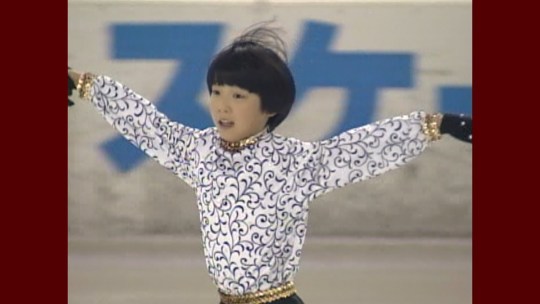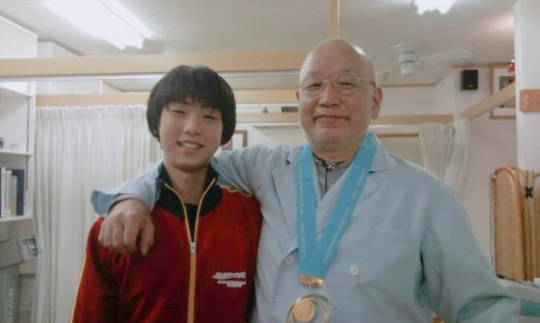#corrected one part: he practised Shorinji Kempo which is based on Shaolin Kungfu
Explore tagged Tumblr posts
Photo

Continuing to translate Kikuchi-san's book ‘Strongly, beautifully, 30 methods to train’ (book on amazonjp)
Chapter 1, part 3. Adjusting the body's axis during a jump
As Yuzuru the athlete's body continued to grow, the content of our conversation during massage also changed a little.
For example, elementary school 4th grader Yuzuru asked me about taking in water during training and competition.
"Sensei, during training and before a competition, how should we drink water?"
"In our days, no matter how thirsty we were during training, we could not drink water. But that approach is incorrect. Now for all of you, staying well hydrated is crucial," I explained and he listened with great interest.
"Oh? Then can I drink it all up at once?" he said.
"No, no, you can only drink what your body can absorb. If you exceed that amount, won't the water be churning in your stomach? Then you won't be able to jump," I answered. "First, take a sip to moisten your mouth, then take 2 sips; if your throat is still thirsty, you can only take one more sip," I taught him.
There were also questions related to competition.
"Before the 6-minute practice, what is a good way to warm up?”
For figure skaters, just before the actual competition, there is a period of 6 minutes for practice. At that time, I didn't know anything about it, but I have the experience of practising Shorinji Kempo (t/n. Japanese martial arts inspired by Shaolin Kungfu), so I used the warm-up for martial arts as a guide to answer him.
Looking back now, figure skating and martial arts are 2 completely different events..... I had done a very careless thing. But still, Yuzuru was responding "mm" and listening attentively.
Another time, I talked about jumping, Yuzuru looked very interested and listened to me quietly.
"When you jump, your legs must stretch fully and straighten...... (t/n. I just translated the first and last few lines of his jumping theory)..... To use the reaction force from the ground effectively, the axis must not drift. If your legs are fully straightened, the axis will not be off. Therefore, the hip joint and the ankle must be in a straight line."
These words made Yuzuru's eyes light up.
To be honest, it was all about jumping on land, totally different from jumping on ice in figure skating. I realised it after a while and kept quiet.
The great thing about this child is that he can think independently. He can analyse my words in his own way, "stretching my legs straight, is that a good way to jump on ice", he can digest it for himself. For an elementary school child, it's rather amazing.
When he entered Tohoku High School, he said this to me, "When I was in elementary school, the jump knowledge sensei taught me, it's the theory for jumping on land, right?"
"Actually, at that time, I also thought it should be different for figure skating jumps," I could only reply like that.
"But what you told me at that time, to fully straighten my legs, I think I found the feeling," he said.
That child always took my words and tried to understand in his own way, always thinking about how to do it in order to use it for himself.
(t/n. rest of this section is about exercise methods and theories, not translated) (pic of 4th grader Yuzu above, credits: unknown)
Chapter 1, part 4. Dashing onto the world stage
When Yuzuru started middle school (junior high), travels clashed with training time, so he had to "graduate" from 'torso training class'. But during his elementary school period, the body torso and other necessary abilities had received continuous exercise, to a certain degree.
He participated in 'abilities exercise' every week. I instructed him on "the need to pay attention to the central axis when moving the body". His body's axis became stable, unnecessary movements decreased, and his sense of balance also became better.
Also, I often had him do the training of making different actions according to the signals; the muscles and joints respond quickly and appropriately to information entering the brain through sight (eyes) and hearing (ears); this also helped to raise the senses.
But I instructed other children in the same way too. Yuzuru was different from others in that, from elementary school age, he was sensitive to words like "become stronger", "become better", "win". Perhaps we can even call it 'greed'.
And also, he was very open and frank. The desire to excel at figure skating, to be stronger, to win.... His awareness was so strong. As a result, he listened earnestly to even someone like me who had no knowledge of figure skating. In my words, he searched for any tiny bit that might help him improve.
In junior level, his competition awareness was already very strong.
When he was 15 years old, before he won the Junior World Championship, he told me, "I must win Junior Worlds." He continued, "The competition standard will be very high, so I definitely want to win."
That child had just won the Junior Grand Prix Final, but he was not satisfied with just that.
Before Junior Worlds, he injured his knee. So he asked me to teach him how to do taping, I naturally taught him all that I could.
Even though his competitions are now on the international stage, he still came to my clinic when he returned and after daily training, getting treatments like massage, tui-na, taping and such.
When I saw him at those times, he was just an ordinary boy. Once, I helped to remove the tape around his injured instep, he said, "Sensei, the pain is gone!" and was happily dancing around. He was boasting a little. (t/n. seems like he was boasting about his own abilities because he had done the taping himself.) So I jokingly said, "I can't do this job anymore!" Hearing my words, he pouted his lips. He was already fighting his battles on the world stage, but in front of me, he was just an ordinary junior high student.

Photo: Kikuchi-san is wearing the Junior GPF 2009 gold medal. :) Yuzu had just turned 15 in this photo and had just won the competition which was held in Tokyo that year. (pic credits: unknown)
I don’t have the book yet so I translated from a Chinese translation in weibo, much thanks to QuailAries. (I left out 2 or 3 sentences; they do not affect the meaning and flow of the section.)
Next parts, 1.5 and 1.6, were already posted earlier (cos I translated them first).
#translation of Kikuchi-san's book#Akira Kikuchi#Yuzuru Hanyu#corrected one part: he practised Shorinji Kempo which is based on Shaolin Kungfu
164 notes
·
View notes